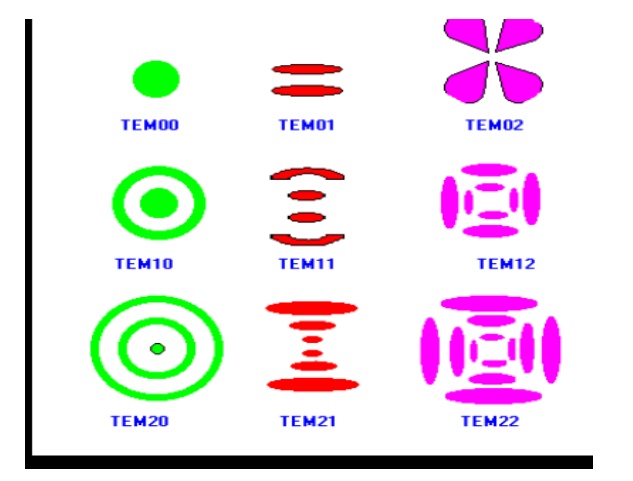Chapter: Fiber optics and Laser instruments : Laser Fundamentals
Laser Modes
Laser Modes
Surely
laser cavity is also very important for a laser in many other aspects, for
example, its dimension decides the longitudinal laser modes. Generally speaking
light modes means possible standing EM waves in a system. The number of modes
in this meaning is huge. Laser mode means the possible standing waves in laser
cavity. We see that stimulated lights are
transmitted
back and forth between the mirrors and interfere with each other, as a result
only light whose round trip distance is integer multiples of the wavelength l
can become a standing wave. That is:
m =
2L/(c/f) =2L/l , or f = m c/(2L), D f = c/(2L)
Where L
is the length of cavity, c is the light speed in laser cavity, f is the
frequency of standing wave, l is the wavelength, m is an integer , D f is the
frequency difference between two consecutive modes. The number of longitudinal
modes may be very large, it can also be as small as only a few (below 10). If
we intersect the output laser beam and study thetransverse beam cross section,
we find the light intensity can be of different distributions (patterns). These
are called Transverse Electromagnetic Modes (TEM). Three index are used to
indicate the TEM modes—TEMplq, p is the number of radial zero
fields, l is the number of angular zero fields, q is the number of longitudinal
fields. We usually use the first two index to specify a TEM mode, like TEM00,
TEM10, etc. Clearly, the higher the order of the modes the more difficult it is
poor to focus the beam to a fine spot. That is why some times TEM00 mode or
Gaussian beam is preferred
TEM Mode, Beam Diameter, Focal Spot Size and Depth
of Focus
Modes are
the standing oscillating electromagnetic waves which are defined by the cavity
geometry. In the above section, we already computed the Longitudinal Modes
frequencies for some simple cases. If the cavity is of closed form, i.e., both
the mirrors and side walls are reflective, there will be large amounts of
longitudinal modes oscillating inside the cavity, a typical value can be 109
modes for a He-Ne laser.
When
these modes oscillate, they interfere with each other, forming the
transversestanding wave pattern on any transverse intersection plane. This
mechanism decides the Transverse Electromagnetic Modes (TEM) of the laser beam,
which is the wave pattern on the output aperture plane. We use the sign TEMpql
to specify a TEM mode, where p is the number of radial zero fields, q is the
number of angular zero fields, q is the number of longitudinal fields, and we
usually use TEMpq to specify a TEM mode, without the third index. A table of
TEM patterns is shown below. Clearly, the mode pattern affects the distribution
of the output beam energy, which will thus affect the machining process. Then
what is the diameter of a laser beam? Usually this diameter is defined as the
distance within which 1/e2 of the total power exists.The higher the order of
the mode, the more difficult it is to focus the beam to a fine spot,since the
beam of higher order is not from a virtual point, but from patterns as those in
the table below.

Focal Spot Size:
Focal
spot size determines the maximum energy density that can be achieved when
thelaser beam power is set, so the focal spot size is very important for
material processing.When a beam of finite diameter D is focussed by a lens onto
a plane, the individual parts of the beam striking the lens can be imagined to
be point radiators of new wave front.The light rays passing through the lens
will converge on the focal plane and interfere with each other, thus constructive
and destructive superposition take place.
Related Topics